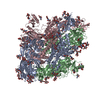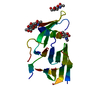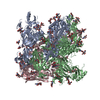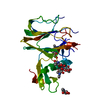[English] 日本語
 Yorodumi
Yorodumi- PDB-7usb: CCoV-HuPn-2018 S in the swung out conformation (local refinement ... -
+ Open data
Open data
- Basic information
Basic information
| Entry | Database: PDB / ID: 7usb | ||||||
|---|---|---|---|---|---|---|---|
| Title | CCoV-HuPn-2018 S in the swung out conformation (local refinement of domain 0) | ||||||
 Components Components | Spike glycoprotein | ||||||
 Keywords Keywords | VIRAL PROTEIN / Human coronavirus / Coronavirus / CCoV-HuPn-2018 / spike glycoprotein / Alpha-coronaviruses / Structural Genomics / Seattle Structural Genomics Center for Infectious Disease / SSGCID | ||||||
| Function / homology |  Function and homology information Function and homology informationhost cell endoplasmic reticulum-Golgi intermediate compartment membrane / receptor-mediated virion attachment to host cell / endocytosis involved in viral entry into host cell / fusion of virus membrane with host plasma membrane / fusion of virus membrane with host endosome membrane / viral envelope / virion membrane / membrane Similarity search - Function | ||||||
| Biological species |  unidentified human coronavirus unidentified human coronavirus | ||||||
| Method | ELECTRON MICROSCOPY / single particle reconstruction / cryo EM / Resolution: 3.1 Å | ||||||
 Authors Authors | Tortorici, M.A. / Veesler, D. / Seattle Structural Genomics Center for Infectious Disease (SSGCID) | ||||||
| Funding support |  United States, 1items United States, 1items
| ||||||
 Citation Citation |  Journal: Cell / Year: 2022 Journal: Cell / Year: 2022Title: Structure, receptor recognition, and antigenicity of the human coronavirus CCoV-HuPn-2018 spike glycoprotein. Authors: M Alejandra Tortorici / Alexandra C Walls / Anshu Joshi / Young-Jun Park / Rachel T Eguia / Marcos C Miranda / Elizabeth Kepl / Annie Dosey / Terry Stevens-Ayers / Michael J Boeckh / Amalio ...Authors: M Alejandra Tortorici / Alexandra C Walls / Anshu Joshi / Young-Jun Park / Rachel T Eguia / Marcos C Miranda / Elizabeth Kepl / Annie Dosey / Terry Stevens-Ayers / Michael J Boeckh / Amalio Telenti / Antonio Lanzavecchia / Neil P King / Davide Corti / Jesse D Bloom / David Veesler /   Abstract: The isolation of CCoV-HuPn-2018 from a child respiratory swab indicates that more coronaviruses are spilling over to humans than previously appreciated. We determined the structures of the CCoV-HuPn- ...The isolation of CCoV-HuPn-2018 from a child respiratory swab indicates that more coronaviruses are spilling over to humans than previously appreciated. We determined the structures of the CCoV-HuPn-2018 spike glycoprotein trimer in two distinct conformational states and showed that its domain 0 recognizes sialosides. We identified that the CCoV-HuPn-2018 spike binds canine, feline, and porcine aminopeptidase N (APN) orthologs, which serve as entry receptors, and determined the structure of the receptor-binding B domain in complex with canine APN. The introduction of an oligosaccharide at position N739 of human APN renders cells susceptible to CCoV-HuPn-2018 spike-mediated entry, suggesting that single-nucleotide polymorphisms might account for viral detection in some individuals. Human polyclonal plasma antibodies elicited by HCoV-229E infection and a porcine coronavirus monoclonal antibody inhibit CCoV-HuPn-2018 spike-mediated entry, underscoring the cross-neutralizing activity among ɑ-coronaviruses. These data pave the way for vaccine and therapeutic development targeting this zoonotic pathogen representing the eighth human-infecting coronavirus. | ||||||
| History |
|
- Structure visualization
Structure visualization
| Structure viewer | Molecule:  Molmil Molmil Jmol/JSmol Jmol/JSmol |
|---|
- Downloads & links
Downloads & links
- Download
Download
| PDBx/mmCIF format |  7usb.cif.gz 7usb.cif.gz | 58.7 KB | Display |  PDBx/mmCIF format PDBx/mmCIF format |
|---|---|---|---|---|
| PDB format |  pdb7usb.ent.gz pdb7usb.ent.gz | 38.1 KB | Display |  PDB format PDB format |
| PDBx/mmJSON format |  7usb.json.gz 7usb.json.gz | Tree view |  PDBx/mmJSON format PDBx/mmJSON format | |
| Others |  Other downloads Other downloads |
-Validation report
| Summary document |  7usb_validation.pdf.gz 7usb_validation.pdf.gz | 1.1 MB | Display |  wwPDB validaton report wwPDB validaton report |
|---|---|---|---|---|
| Full document |  7usb_full_validation.pdf.gz 7usb_full_validation.pdf.gz | 1.1 MB | Display | |
| Data in XML |  7usb_validation.xml.gz 7usb_validation.xml.gz | 26.4 KB | Display | |
| Data in CIF |  7usb_validation.cif.gz 7usb_validation.cif.gz | 34.1 KB | Display | |
| Arichive directory |  https://data.pdbj.org/pub/pdb/validation_reports/us/7usb https://data.pdbj.org/pub/pdb/validation_reports/us/7usb ftp://data.pdbj.org/pub/pdb/validation_reports/us/7usb ftp://data.pdbj.org/pub/pdb/validation_reports/us/7usb | HTTPS FTP |
-Related structure data
| Related structure data |  26731MC  7u0lC  7us6C  7us9C  7usaC M: map data used to model this data C: citing same article ( |
|---|---|
| Similar structure data | Similarity search - Function & homology  F&H Search F&H Search |
- Links
Links
- Assembly
Assembly
| Deposited unit | 
|
|---|---|
| 1 |
|
- Components
Components
| #1: Protein | Mass: 37624.590 Da / Num. of mol.: 1 Fragment: CCoV-HuPn-2018 S domain 0 in swung out conformation Source method: isolated from a genetically manipulated source Source: (gene. exp.)  unidentified human coronavirus unidentified human coronavirusProduction host:  References: UniProt: A0A8E6CMP0 | ||||
|---|---|---|---|---|---|
| #2: Polysaccharide | 2-acetamido-2-deoxy-beta-D-glucopyranose-(1-4)-2-acetamido-2-deoxy-beta-D-glucopyranose Source method: isolated from a genetically manipulated source | ||||
| #3: Sugar | | Has ligand of interest | N | Has protein modification | Y | |
-Experimental details
-Experiment
| Experiment | Method: ELECTRON MICROSCOPY |
|---|---|
| EM experiment | Aggregation state: PARTICLE / 3D reconstruction method: single particle reconstruction |
- Sample preparation
Sample preparation
| Component | Name: CCoV-HuPn-2018 / Type: VIRUS / Entity ID: #1 / Source: RECOMBINANT |
|---|---|
| Source (natural) | Organism:  |
| Source (recombinant) | Organism:  |
| Details of virus | Empty: YES / Enveloped: YES / Isolate: OTHER / Type: VIRION |
| Natural host | Organism: Homo sapiens |
| Buffer solution | pH: 8 |
| Specimen | Embedding applied: YES / Shadowing applied: NO / Staining applied: NO / Vitrification applied: YES |
| EM embedding | Material: Tris buffer saline |
| Vitrification | Cryogen name: ETHANE |
- Electron microscopy imaging
Electron microscopy imaging
| Experimental equipment |  Model: Titan Krios / Image courtesy: FEI Company |
|---|---|
| Microscopy | Model: FEI TITAN KRIOS |
| Electron gun | Electron source:  FIELD EMISSION GUN / Accelerating voltage: 300 kV / Illumination mode: FLOOD BEAM FIELD EMISSION GUN / Accelerating voltage: 300 kV / Illumination mode: FLOOD BEAM |
| Electron lens | Mode: BRIGHT FIELD / Nominal defocus max: 1500 nm / Nominal defocus min: 800 nm |
| Image recording | Electron dose: 80 e/Å2 / Film or detector model: GATAN K3 (6k x 4k) |
- Processing
Processing
| CTF correction | Type: PHASE FLIPPING AND AMPLITUDE CORRECTION |
|---|---|
| 3D reconstruction | Resolution: 3.1 Å / Resolution method: FSC 0.143 CUT-OFF / Num. of particles: 102954 / Symmetry type: POINT |
 Movie
Movie Controller
Controller





 PDBj
PDBj

